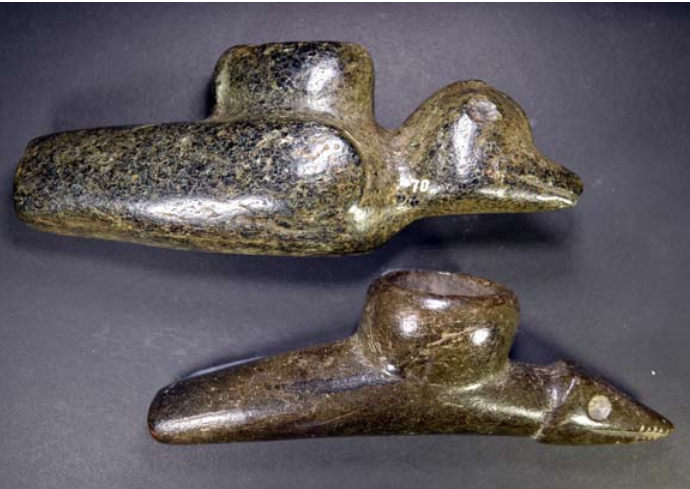|
Several Types of Prehistoric Tennessee Pipes
|
by Steve Hart, |
| Central States Archaeological Societies 2018 October Journal |
Huntington, Indiana
|
| This excerpt from "Several
Types of Prehistoric Tennessee Pipes" published in the 2018
Central States Archaeological Societies 2018
October Journal
Read the complete
12 page column in the Central States Archaeological Societies 2018
October Journal which
can be purchased on-line after March 2019
|
|
At top: Figure 85 in The Antiquities of Tennessee
and the Adjacent States (1890) by Gates P. Thruston. The caption reads:
The large stone pipe (Fig.85), representing a kneeling human figure
is also an ancient type. It is in the fine collection of General J.T.
Wilder, now of Johnson City, Tennessee, and was discovered near Kingston,
Tennessee. The material of which it is composed is a compact, reddish
brown stone, probably jasper or shale. It is six inches in height.
Thruston also states: General Wilder has one of the largest and most
carefully selected collections of antiquities in the South, and kindly
sent the author a large number of specimens for examination and comparison. |
Tennessee has seen a number of outstanding archaeologists, students and
collectors of prehistoric peoples and their artworks. Three collections come
to mind as being outstanding, above all the rest of their time. Early in
the nineteenth century President Andrew Jackson (1767-1845) cabineted a number
of fine artifacts during his days at the Hermitage. Later in that century,
General Gates B. Thruston (1835-1912) assembled a collection of prehistoric
artforms of both high quality and high quantity. Much of his
material came from local Mississippian period sites in and around the
Nashville area. During the middle part of the 20th century, Tennessee relic
collecting was led by Dr. T. (Thomas)
Hugh Young (1891-1962) of Nashville. Dr. Young, in his collecting quest, accumulated some of the
finest relics ever recovered. One collecting facet that was shared by all
three of these gentlemen was their admiration of prehistoric men and women,
and their smoking pipes and traditions.
Of the three collectors, General Thruston was the most prolific writer,
authoring books on Civil War history and Tennessee prehistory. Thruston was
a Civil War General, then a Nashville attorney and an amateur archeologist.
His prehistoric gatherings became well known regionally and in 1890 the Tennessee
Historical Society requested he create an illustrated pamphlet of his
collection. Thruston, then Vice President of the Society, generated a fully
illustrated book of some 380 pages. His work sold for four
dollars a copy, less than its actual production cost. He personally covered the additional costs such that
his work could be widely available to collectors and students. A second updated
edition of his work containing new chapters, notes and illustrations followed
in 1897. Thruston’s knowledge and collection became known world-wide
and he was asked to display his assemblages in Madrid, Spain at the 1893
Columbian Historical Exposition. This was followed in 1897 at the Tennessee
Centennial Exposition, and later at the Louisiana Purchase Exposition in
St. Louis. He was also asked to be the Tennessee representative and exhibited
in Paris, France at a French Exposition.
His work The Antiquities of Tennessee and the Adjacent States captured
much of the contemporary knowledge of local avocationalists and professional
archaeologists in the mid-South communities, and featured collections from
Tennessee and neighboring states.
This became THE textbook, and related to the Archaic, Woodland, Mississippian,
as well as some contemporary period history of the time. In 1907 General
Thruston attempted to donate his entire collection to the State of Tennessee,
should the state provide space and security for his assemblage. When the
state legislature could not or would not come up with sufficient funding,
he donated the collection to Vanderbilt University, Nashville. It remained
there until 1986, when Vanderbilt and the Tennessee State Museum Nashville
jointly agreed to incorporate Thruston’s collection into the Museum’s
permanent exhibit area, where it remains today.
Read the complete 12 page column in the Central States Archaeological Societies 2018
October Journal which can be purchased on-line after March 2019

|
Figure 14. President Jackson Great
Pipes: Duck Effigy Pipe – Clinton
County, Kentucky #A-6, and Animal Effigy Pipe – Cumberland
County, Kentucky#A-1. |
|
Read the complete 12 page column in the Central States Archaeological
Societies 2018 October Journal which
can be purchased on-line after March 2019 |
|
|




